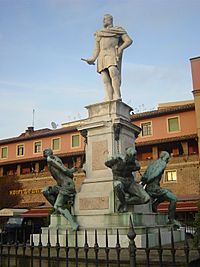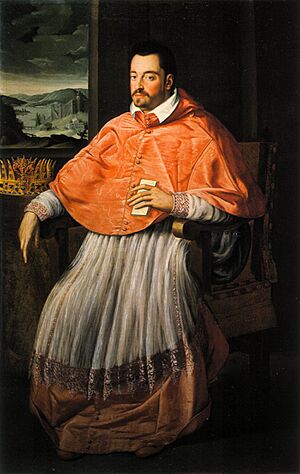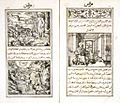Ferdinando I de' Medici, Grand Duke of Tuscany facts for kids
Quick facts for kids Ferdinando I |
|||||
|---|---|---|---|---|---|

Portrait by Scipione Pulzone, 1590
|
|||||
| Grand Duke of Tuscany | |||||
| Reign | 19 October 1587 – 7 February 1609 | ||||
| Predecessor | Francesco I | ||||
| Successor | Cosimo II | ||||
| Born | 30 July 1549 Florence |
||||
| Died | 3 February 1609 (aged 59) Florence |
||||
| Spouse | Christina of Lorraine | ||||
| Issue |
|
||||
|
|||||
| House | Medici | ||||
| Father | Cosimo I de' Medici, Grand Duke of Tuscany | ||||
| Mother | Eleanor of Toledo | ||||
Ferdinando I de' Medici was an important ruler of Tuscany, a region in Italy. He was known as the Grand Duke of Tuscany from 1587 to 1609. Ferdinando took over this role after his older brother, Francesco I, passed away. He was born on July 30, 1549, and died on February 3, 1609.
Contents
Early Life and Cardinal Role
Ferdinando was one of the many sons of Cosimo I de' Medici, Grand Duke of Tuscany, and Eleanor of Toledo. His father, Cosimo I, was a powerful ruler.
When Ferdinando was just 13 years old, he became a Cardinal in 1562. A cardinal is a high-ranking official in the Catholic Church, chosen by the Pope. Even though he was a cardinal, Ferdinando never became a priest.
He lived in Rome for a while and was very good at managing things. He started the Villa Medici, a famous building in Rome. He also collected many beautiful artworks, like the Medici lions. Later, he brought these art pieces back to his home city of Florence.
Becoming Grand Duke
In 1587, Ferdinando's older brother, Francesco I, died. This meant that Ferdinando, at 38 years old, became the new Grand Duke of Tuscany.
Ferdinando was quite different from his brother. He was friendly and generous. He wanted to rule fairly and cared about the people he governed. Under his rule, Tuscany became strong and independent again.
Helping Trade and People
Ferdinando worked hard to improve trade. He made a lot of money through the Medici banks, which were in major cities across Europe. He also made a rule that allowed Jews and other religious groups to live safely in Tuscany. Because of this, the city of Livorno became a safe place for many people who were being treated unfairly in other countries.
He also started the Medici Oriental Press, called Typographia Medicea. This printing house published many books in the Arabic language.
Improving Infrastructure
Ferdinando made the harbor that his father had built even better. He also changed the path of part of the Arno River to create a canal called the Naviglio. This canal helped trade between Florence and Pisa. He also started projects to water dry lands, which helped farmers grow more crops in areas like Pisa and Fucecchio.
Opera in Florence
A big cultural event during Ferdinando's time was the start of opera in Europe. For the wedding of his niece, Marie de' Medici, to King Henry IV of France in 1600, Ferdinando's court put on a grand show. It was one of the very first operas, called Euridice, created by Jacopo Peri.
Marriage and Family
For the first two years as Grand Duke, Ferdinando kept his cardinal title. But in 1589, he gave it up to marry Christina of Lorraine. Their wedding reception was a huge party at the Medici Villa in Poggio a Caiano.
Christina brought a very large dowry with her. A dowry is money or property that a bride brings to her marriage. Her dowry included a lot of cash and valuable jewelry. Also, the rights to the Duchy of Urbino were passed to Christina. This meant that future Medici rulers would have a claim to this duchy.
Ferdinando and Christina had many children:
- Cosimo II (1590–1621), who became the next Grand Duke.
- Eleonora (1591–1617)
- Catherine (1593–1629)
- Francesco (1594–1614)
- Carlo (1595–1666)
- Filippino (1598–1602)
- Lorenzo (1599–1648)
- Maria Maddalena (1600–1633)
- Claudia (1604–1648)
Foreign Relations

Ferdinando wanted Tuscany to be free from the control of Spain. After the French King Henry III of France was killed in 1589, Ferdinando supported Henry IV of France. He helped Henry IV in his fight against the Catholic League and even lent him money. Ferdinando also encouraged Henry to become Catholic, which he eventually did. Ferdinando used his influence with Pope Clement VIII to help Henry's conversion be accepted.
However, Henry IV did not show much thanks for Ferdinando's help. So, Ferdinando decided to keep his distance and focus on Tuscany's independence. He supported Philip III of Spain in a military campaign in Algeria. He also helped Holy Roman Emperor Rudolf II in his fight against the Turks. To pay for these efforts, Ferdinando had to raise taxes on his people. He also officially gained control of Siena, a city his father had conquered.
Tuscan Fleet and Exploration
Ferdinando made the Tuscan navy stronger. This fleet won battles against pirates on the Barbary Coast in 1607. The next year, they even defeated a larger Turkish fleet.
Ferdinando also dreamed of creating a small empire in Africa. He even thought about starting a colony in Brazil. A few months before he died, in 1608, Ferdinando sent an expedition led by Captain Robert Thornton to northern Brazil and the Amazon River. The goal was to set up a new colony there.
Images for kids
-
Portrait by Scipione Pulzone, 1590
-
Pietro Tacca's Monumento dei Quattro Mori (Monument of the Four Moors) in Leghorn, showing Ferdinando holding baton of a field marshal standing victorious above chained Moorish captives. (1623)
See also
 In Spanish: Fernando I de Médici para niños
In Spanish: Fernando I de Médici para niños







